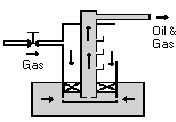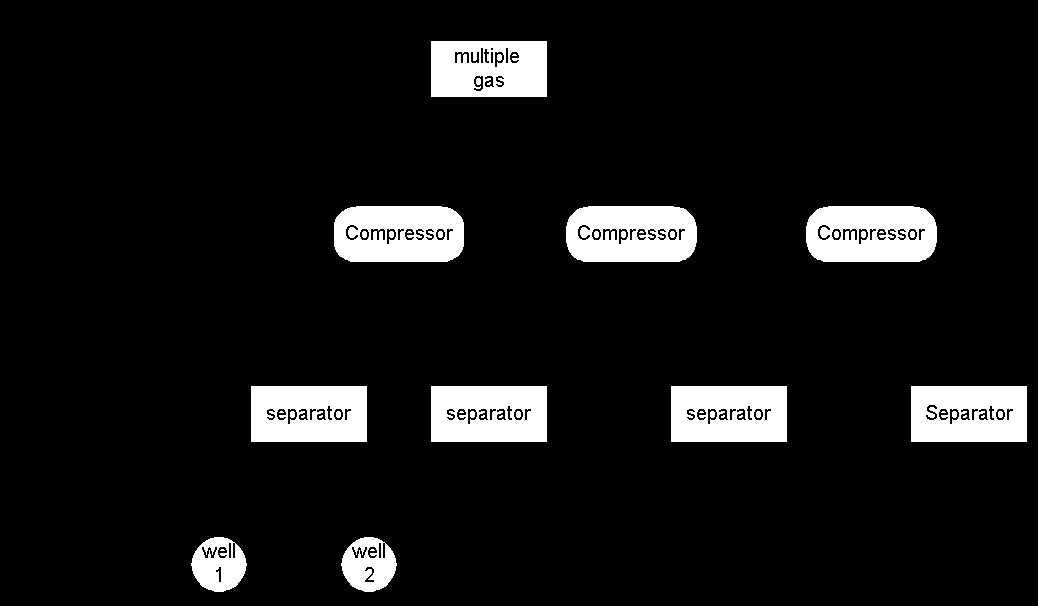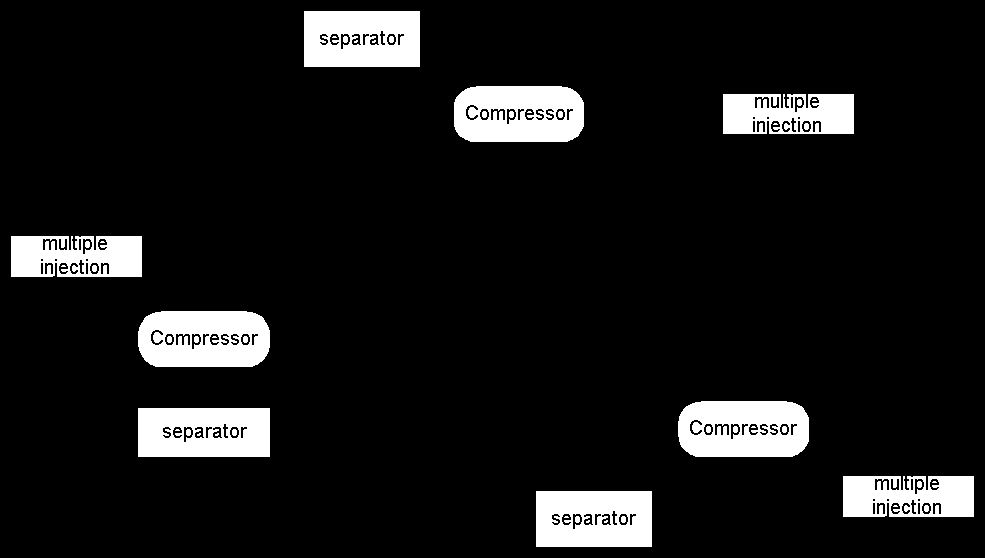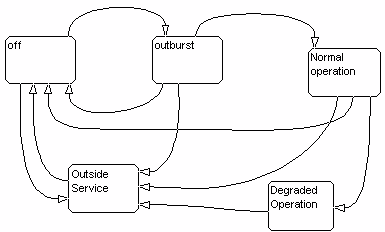
Gas Process Automation in the Petroleum Production
1
Universidad de Los Andes, Postgrado en Automatización e Instrumentación, LabIDAIFacultad de Ingeniería, Mérida, Venezuela
2
Universidad de Los Andes, Departamento de Computación, Facultad de Ingeniería, Mérida, Venezuela3
UNEXPO-Vicerrectorado Puerto Ordaz. VenezuelaTelefax :58-74-403823. email : jesusc@ing.ula.ve, echacon@ing.ula.ve
Abstract
Production area in the petroleum business involves the extraction, transport and storage activities of fluids coming from hydrocarbon deposits yields. Extraction process uses gas as input to maintain the pressure in the hydrocarbon deposits and to rise oil (gas lift). The gas is carried out for distributing to final uses that include: a) commercial distribution; b) maintain internal yield pressure; c) gas lift oil production; d) fuel gas. These activities in the gas process are carried out under some established objectives and watchwords that allow good operation of total process. Management of information technologies is central in process automation nowadays, and it is necessary to integrate the different production systems, with the objective of achieving better efficiency and smallest possible time to take decisions. The objective of work consists in the information integration of have multiple exploitation units (EU) to carry out the automation of the gas process.
1. Introduction
Petroleum business includes a group of closely related areas. That are decisive in its handling and profitability. Those areas are exploration, production, refinement and marketing. So, the most complex area is production, because it involves the extraction, transport and storage activities of fluids coming from hydrocarbon deposits yields. In general oil production, the management production is divided in to extraction (gas and fluids generates), separation and treatment of gas and oil. Extraction process uses gas as input to maintain the pressure within the hydrocarbon deposits and to rise oil (gas lift). The gas process begins when gas coming from the yield with oil is separated. After that, it passes to compression stations to elevate its pressure. The gas is carried out for distributing to final uses that include a) commercial distribution; b) maintain internal yield pressure; c) gas lift oil production; d) fuel gas. These activities in the gas process are carried out under some established objectives and watchwords that allow a good operation of total process. Some production regions have multiple exploitation units (EU) of oil locations; they include flow collection units, gas compression complexes and active wells. All EU has it own supervisory control and data acquisition system (SCADA) with similar technologies. These systems SCADA have interconnection among them, therefore, they are not integrated to carry out the management and coordination in an automated form. In this situation, considerable production losses has been generated due the coordination operations are no automated and they are performed by phone or radio communication among control rooms. The operations are not coordinated in precise form and on time. It is also necessary to consider that the interaction among the UE is very narrow and sensitive to changes of operation conditions. Management of information technologies is central in processes automation nowadays, and it is necessary to integrate the different production systems, with the objective of achieving better efficiency and smallest possible time to take decisions. This work describes the gas process first as well as it is carried out the actual management, after is specified what is necessary information in the coordination and take decisions, subsequently it is intends a strategy to integrate the existent technology that consists on placing a superior level of supervision where it is concentrated the information of each SCADA; in such way, allowing the information arrives to coordination and planning levels, and lastly it is carried out an analysis advantages of the proposal and conclusions are mentioned.
This paper is organised in five sections; one is an introduction to the problem. In section two is described the gas process. In section three is show the solution, in the section four is described the results and the section final is conclusions.
2. Gas Process: The Problem
Gas as secondary product in oil production must be treated for commercial purposes and surplus must be re-injected. As result of the production, oil reservoirs characteristics changes and new production methods must be introduced in order to maintain the production level. One of the production methods is the gas lift method that consists in perform gas injection at level of the reservoir to help the oil come out (gas lift), see figure 1.

Figure 1. Gas lift production method
Oil reservoirs are scattered over a large geographical area and the gas is recovered from the production must be treated and compressed for injection at the wells and transportation for commercial uses; the surplus gas is injected for future uses. The whole cycle in oil production by gas lift method is show in figure 2.

Figure 2 Gas lift method
To treat gas, special facilities are built; those facilities must be interconnected to distribute the gas. The number of gas facilities depends of size of reservoirs, the placement of the wells, and the capacity of the facilities. The topology of the facilities is bus (figure 3) or an interconnected graph (figure 4).

Figure 3 Bus topology in gas lift production

Figure 4 Interconnected graph in gas lift production
In each compression complex it can have any, one or more compression trains working. A train can be out, in outburst, in degraded operation or outside of service.
For the case of study, several compression complexes exist, each one with their respective control system equipment. The current state allows to the operators in control room to observe the behaviour of the compression systems and when taking place decrease of pressure in the complex the pressure within the pipelines is increased, to allow make decisions that can delay until one hour.
The existence of a coordination system than can improve the make decision process allows the reduction of pressure within the pipelines, minimising usage of compressor and energy consumption.
3. Integrated Automation: The Solution
Automated production systems and the integrated production information management, it is necessary for competition reasons, the time of marketing for the products becomes shorter every day. For it, to reduce the times of development, the departments of the organisation need to cooperate efficiently [1].
The exchange of information is for electronic means and the initial focus to implement these systems it is in reducing the quantity of paper, to create digital documents. The key of the first step is in the use of automated processes and with standard or free formats for the data that are exchanged among the processes. Some departments are fully automated forming automation islands. Process information is automatically recovered from the control system and stored in data reservoirs to support the make decisions activities. For a real benefit of the automation within the departments in a general way, it is necessary to integrate them in a true whole automated process. The key of the next step is the integration of the database of products that it contains the total pattern of the product to settle down.
The integration of the information of the SCADA in a database it is using a net of local area. It allows to establish a level hierarchical superior for the coordination of the process of gas, under a structure of control híbrido[2]. Following the procedure presented by Chacón[2], he has the pattern of operation of the compression complex, the one which, it is shown in graph of the figure 4, representing the Finite State Machine[5] (FSM).
The integration takes into account failures in each one them the compression station and coordinates to achieve a optimal global operations.
The automated system should emulate the manual tasks carried out by the operator in control room at the presence of events and interferences that affect the normal operation of the complex of gas compression.

Figure 5 States of the compressor station
4. Results
The information is integrated (see figure 6) using the level of direct control and systems SCADA at the level coordinador/supervisor, by means of the shipment through the net of the system, of distinctive labels and value of the variables and order discreet control, toward the database of each level.

Figure 6 Integrated Information Diagram
The time of answer is smaller, therefore, this diminish the production costs, the system uses the existent infrastructure and the databases and computers are only added to the coordinating level. Behavioral models in terms of FSM are developed for each one of the stations and they are stored on the coordination centers.
Simulations of the global system to evaluate the combination of the stations are performed to select an optimal operation.
5. Conclusions
The improvement of the coordination activities allows a reduction of the making decisions activities, allowing a reduction of the pressure within the system, minimising energy consumption and we expect a less usage of the equipment.
It is demonstrated that the systematic focus the scheme of hierarchical state is characterizes for to descriptive economy that allows to simplify the controller's design
6. References
[1] Teew, W. B., and J.R Liefting. "Experiences with product data interchange: On product models, integration and standardisation". Computers in Industry. Vol. 31. 1996. Pp. 205-221.
[2] E. Chacón, W. Moreno, J.C. Hennet. "Toward an Implementation of Hierarchical Hybrid Control Systems for the Integrated Operation of Industrial Complexes". CESA'96 IMACS Multiconference. Lille, France. July 1996.
[3] A. Sanchez. "Formal Specification and Synthesis of Procedural Controllers for Process Systems" Springer – Verlag London. 1996.